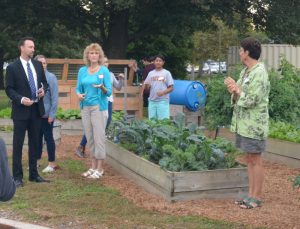GreenStrides Tour visits middle school for extensive tour
By Mike McGann, Editor, The Times

Patton Middle School teacher Betsy Ballard talks about the history of green efforts at the school dating back to 2010, as prinicipal Tim Hoffman (left) and Phoebe Kittson (right) of the Chester County Food Bank look on.
EAST MARLBOROUGH — Charles F. Patton Middle School enjoyed both federal state recognition this week for its efforts as a “green” school — which probably surprises few in the area accustomed to seeing regular harvests from the school’s raised beds, or hearing of donations to local food banks among things since the school started on a “green” path in 2010.
As part of the U.S. Department of Education’s Green Strides Tour, federal and state officials came to the school Wednesday — a year after it was honored as a Green Ribbon School — to celebrate the many educational and environmental accomplishments at the school.
Andrea Falken, the U.S. Department of Education’s Director of Green Ribbon Schools and David Bauman, director of Green Ribbon Schools for the state Department of Education joined a mix of district officials, board of education members, teachers and students for a your of the expansive facilities at Patton — used across the educational spectrum — to teach students in sixth through eighth grade while giving back to the community.
“I am so amazed,” Bauman said after the tour, addressing the gathering. “I will contacting you in the future so you can show the way for other districts.”
After a quick reception and a few remarks by Superintendent of Schools John Sanville and Patton Principal Tim Hoffman, the tour walked the officials through the solar-powered greenhouses out behind the transportation garage — greenhouses that used to be manually maintained, but now enjoying a sophisticated digital control system, installed and designed by Tri-M, one of a number of local companies that have been supportive of Patton’s efforts over the last few years.
Joel Smith, representing Tri-M at the event, suggested the new system was a perfect environment for students interested in STEM — Science, Technology, Engineering and Math.
Aside from improving yields — and cutting the need for teachers to manually control the moisture and sunlight for the plants in the greenhouse — the new system generates data that can be used in math and science classes at the school, to allow data-driven analysis, in some cases on a real-time basis by students. The sensors in the greenhouse are connected to computers in the school, accessible by students.
From there the tour moved to the outdoor classroom built in 1998 — one of the school’s earliest environmental efforts — to talk about it’s newest — a planned American Chestnut grove, as part of a wider effort to restore the once plentiful tree to the forests of the northeast.
Sixth grade teacher Ryan Ragland talked a bit about the ambitious plan to plant 100 trees in the grove as part of the American Chestnut Project. Once one of the dominant species of tree in the area (it made up some 30% of the hardwoods, Ragland said), the American Chestnut was all but wiped out by a blight starting in 1904 — other than in some limited portions of Allegheny County.
The ambitious plan calls for 100 seeds to be nurtured by the district elementary students — as part of a science curriculum — into healthy saplings. Once that’s accomplished, the grove will be planted in an open area and monitored by middle school students, again, their growth being tracked as part of science curriculum.
The tour ended where Patton’s move toward becoming a green paragon — the raised beds in front of the school, which became a reality in 2011.
Phoebe Kittson of the Chester County Food Bank talked about the impact the beds have had for local food banks — and how they spurred others to join the effort. There are now 600 raised beds around the county in 150 locations, but she noted, as led by Patton teachers Betsy Ballard and Kim Hisler, few are as productive as the Patton beds, which are growing or harvesting 365 days a year in four growing seasons. Some 20,000 pounds of fresh produce has gone to food banks in the county — often the hardest and most sought after foodstuffs.
Just last week, Ballard noted, they were able to deliver 175 pounds of produce to the Kennett Community Cupboard — the biggest harvest ever from the beds.
Aside from the impact on the community, the impact on Patton students has been even bigger — students participate in the entire process of growing and harvesting and learn important lessons about the environment and healthy eating.
Again — as they have from the beginnings of the project — Ballard and Hisler expressed appreciation for former Patton Principal Bruce Vosburgh, who was part of the gathering Wednesday. Vosburgh greenlit the initial stages of the project and continued to be a strong supporter until his retirement. Both also thanked Hoffman for his unwavering and continuing support as the project grew.






